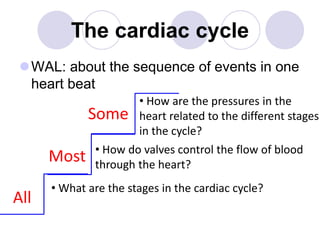
the-cardiac-cycle-1-powerpoint.ppt
- 1. The cardiac cycle WAL: about the sequence of events in one heart beat All Most Some • What are the stages in the cardiac cycle? • How are the pressures in the heart related to the different stages in the cycle? • How do valves control the flow of blood through the heart?
- 2. Today we are covering from the specification:
- 3. © Boardworks Ltd 2004 3 of 49 Preventing backflow Blood always flows in the same direction as it moves through the heart during each circulation of the body. Why is it important that blood does not flow backwards?
- 4. © Boardworks Ltd 2004 4 of 49 The chambers of the heart are separated by valves which prevent blood from flowing in the wrong direction. Heart valves There are valves between the atria and the ventricles… …and there are valves leading out of the ventricles. valve between right atrium and right ventricle valve between left atrium and left ventricle valve leading out of right ventricle valve leading out of left ventricle
- 5. © Boardworks Ltd 2004 5 of 49 Naming the heart valves
- 6. © Boardworks Ltd 2004 6 of 49 How are valves held in place? The valves between the atria and ventricles are connected to the inner walls of the heart by tough tendons. valve open
- 7. © Boardworks Ltd 2004 7 of 49 How are valves held in place? The tendons allow the valves to close and hold the valve flaps in place. They prevent the valves from flipping up and turning inside out. Why is this important? valve open valve closed
- 8. Definitions Systole = period of ventricular contraction. Diastole = period of ventricular relaxation. NOTE: Normally diastole is longer than systole.
- 9. Cardiac cycle General Principles. Contraction of the myocardium generates pressure changes which result in the orderly movement of blood. Blood flows from an area of high pressure to an area of low pressure, unless flow is blocked by a valve. Events on the right and left sides of the heart are the same, but pressures are lower on the right.
- 10. As a chamber fills with blood, the pressure is going to rise. When a chamber contracts, the pressure is going to rise. Changes in pressure affect whether a valve is open or closed. Fluids always move from areas of high pressure to areas of low pressure.
- 11. Let us think through the cardiac cycle in terms of pressure: As the blood passes into the atria, the valves are open so most will fall immediately into the ventricle. There is a gradual rise in pressure in the atria until the end of atrial systole when the blood has moved into the ventricles.
- 12. The intraventricular pressure rises as the ventricles fill with blood. This closes the AV valves. Contraction of the ventricles means that the intraventricular pressure is higher than the pressure in the artery which forces the blood out of the ventricle and into the aorta or pulmonary artery (depending on which side of the heart you’re looking at).
- 13. The increase in pressure of the artery causes the closing of the semilunar valves preventing the back flow of blood into the ventricle.
- 15. 15 of 24 © Boardworks Ltd 2008 Cardiac output The amount of blood pumped around the body is called the cardiac output, and depends on two factors: the heart rate – the number of times the heart beats per minute. A typical value for an adult at rest is 70bpm. the stroke volume – the volume of blood pumped by the left ventricle in each heart beat. A typical value for an adult at rest is 75ml. cardiac output = stroke volume × heart rate A typical resting cardiac output is 4–6 litres per minute. This can rise to as much as 40 litres per minute in highly trained endurance athletes.
- 16. Atrial systole The heart is full of blood and the ventricles are relaxed Both the atria contract and blood passes down to the ventricles The atrio-ventricular valves open due to blood pressure 70% of the blood flows passively down to the ventricles so the atria do not have to contract a great amount.
- 17. Ventricular systole The atria relax. The ventricle walls contract, forcing the blood out The pressure of the blood forces the atrio- ventricular valves to shut (producing the heart sound ‘lub’)
- 18. Ventricular systole The pressure of blood opens the semi-lunar valves. Blood passes into the aorta and pulmonary arteries.
- 19. Diastole The ventricles relax Pressure in the ventricles falls below that in the arteries Blood under high pressure in the arteries causes the semi lunar valves to shut. This produces the second heart sound, ‘dub’. During diastole, all the muscle in the heart relaxes.
- 20. Blood from the vena cava and pulmonary veins enter the atria. The whole cycle starts again.
- 22. 5 mins – try it yourself! Match the letter on the graph to the following events Semi-lunar valves open Atrio-ventricular valves close, Semi-lunar valves close Atrio-ventricular valves open Pressure in ventricle higher than in atria – shuts atrioventricular valves to prevent backflow A
- 23. Pressure in ventricle higher than in atria – shuts atrioventricular valves to prevent backflow Pressure in ventricle higher than in aorta– opens semi lunar valves Pressure in aorta higher than ventricles – shuts semi lunar valves Pressure in atria higher than in ventricles – atrioventricular valves open
- 24. Activities 1. Card sort – put the statements into the correct order to show the events that occur during the cardiac cycle. 2. Try the questions on your worksheet. You may wish to use the textbook to help you interpret the information on the graph.